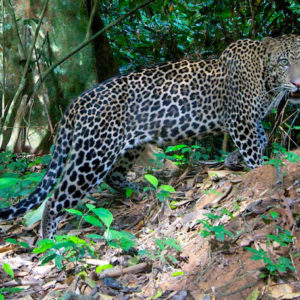
Research by Washington University in St. Louis anthropologist Crickette Sanz, PhD ’04, and research associate David Morgan, PhD, has spurred the Republic of Congo to enlarge its Nouabalé-Ndoki National Park boundaries to include the Goualougo Triangle. The Goualougo Triangle is a remote, pristine forest that is home to at least 14 communities of “naïve” chimpanzees with little exposure to humans.
The expansion, announced in January 2012, increases the size of the protected area by 144 square miles to encompass 1,636 square miles of forest in northern Republic of Congo.
“This expansion is a great victory for scientists and conservationists because the Goualougo area and its animal populations are unique throughout the globe.”
—Crickette Sanz, PhD
“This expansion is a great victory for scientists and conservationists because the Goualougo area and its animal populations are unique throughout the globe, and it holds great promise for further research in many different fields, including anthropology,” Sanz says.
As co-directors of the Goualougo Triangle Ape Project, Sanz and Morgan, along with a team of Congolese researchers, work to improve the conservation status of apes through applied conservation research, enhanced protection of important ape populations and their habitats, and strengthening the local capacity to implement conservation programs.
In August 2011, Kathleen Fields, publications editor in Arts & Sciences, communicated with Sanz via satellite email. Sanz, who was on a research trip to the Republic of Congo, was stationed at the Goualougo Triangle Ape Project base camp.
Q: Tell us where you are — country, terrain, etc.
A: I am in the Goualougo Triangle, which is located along the southern border of the Nouabalé-Ndoki National Park in northern Republic of Congo.
Q: How did you get there?
A: We drove our van of luggage from St. Louis to Atlanta, flew Air France from Atlanta to Paris, flew Air France from Paris to Brazzaville [Republic of Congo], flew on a domestic flight from Brazzaville to Ouesso, took a five-hour, dugout-canoe trip from Ouesso to Bomassa, then a 30km truck ride from Bomassa to Ndoki, traveled in a smaller dugout canoe from Ndoki to Mbeli, and then hiked six hours from Mbeli to finally arrive at the Goualougo base camp.
Q: Who’s with you?
A: Dave Morgan, conservation and research fellow of the Wildlife Conservation Society and Lincoln Park Zoo; two second-year graduate students in the anthropology department (Washington University); two Congolese research assistants, who have degrees from the Marien Ngouabi University in Brazzaville; ten Ba’aka (semi-Nomad people) men who work as forest guides; and one Ba’aka woman who works as our camp cook.
Q. Where are you living? What are the conditions like?
A. The Goualougo Triangle Ape Project’s base is a tented camp. We also have some screened office tents. All of our cooking is done over a campfire. Electricity is generated by a small array of 10 solar panels. There is no running water, so we bathe in a nearby stream.
Q. How long is your trip?
A. I will be in Congo for a little over three months, and then I have a two-week layover in Europe to work with collaborators at the Max Planck Institute for Evolutionary Anthropology in Leipzig, Germany.
Q. What are you doing (both your research objectives and your day-to-day activities)?
A. David Morgan and I are co-directors of the Goualougo Triangle Ape Project, which is a site-based research and conservation program in northern Congo’s Nouabalé-Ndoki National Park. In 1999, the project was initiated to increase our knowledge of the central subspecies of chimpanzee and use this information to address the threats facing these apes in western equatorial Africa. We recently expanded the scope of this project to include a focus on the western lowland gorillas that coexist with chimpanzees in the Congo Basin. Each day, we head into the forest with a team of guides to track chimpanzees and gorillas.
Q. What did you bring with you?
A. We brought a total of 16 pieces of luggage, which totaled a little less than 1,000 lbs. This included everything that one might need to live in the forest for three months, as well as all the gear that our field teams would need to continue our research over the next six months.
Q. Who/what entity is funding the trip?
A. U.S. Fish and Wildlife Service; Conservation, Food and Health Foundation; Great Ape Taxon Advisory Group of the American Zoological Association; Arcus Foundation
Q. How many times have you been there?
A. At least 10 trips, which vary in duration from a couple of months to more than a year.
Q. Where else do you do this type of research?
A. We have a very active collaboration with the Saint Louis Zoo. The Washington University graduate students spent an entire year observing the chimpanzees, gorillas and orangutans in Forest Park before traveling to Congo. This enables them to test their research protocols and data-collection devices before arriving in Congo.
Q. What do you love most about being there?
A. Making discoveries that expand the perspectives of physical anthropologists and scientists in other disciplines.
Q. What do you miss from home?
A. Family
Information for the introduction provided by Jessica Daues, associate Record editor and senior news writer; the Q&A interview provided by Kathleen Fields, publications editor in Arts & Sciences.
For more information, visit the Goualougo Triangle Ape Project.
Read more about recent conservation efforts in the university’s Newsroom.
Read the February 2010 National Geographic article on the Goualougo Triangle Ape Project.








